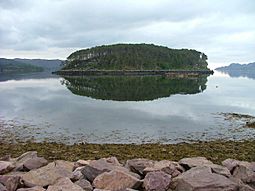Shieldaig Island facts for kids
 |
|
| OS grid reference | NG8100554312 |
|---|---|
| Coordinates | 57°31′32″N 5°39′33″W / 57.525631°N 5.6591314°W |
| Physical geography | |
| Area | 13 hectares (0.05 sq mi) |
| Highest elevation | 134 feet |
| Administration | |
| Sovereign state | United Kingdom |
| Country | Scotland |
| Council area | Highland |
Shieldaig Island is a small island located in Loch Shieldaig, a beautiful sea loch in the Highland area of Scotland. It's a special place known for its tall trees and many birds. The island is about 0.25 miles (0.40 km) away from the village of Shieldaig.
The island covers an area of 13 hectares (that's about 32 acres) and its highest point is 134 feet above sea level. Since 1970, Shieldaig Island has been looked after by the National Trust for Scotland. This organization helps protect important natural and historical places.
Discover Shieldaig Island
Shieldaig Island is a hidden gem in the Scottish Highlands. It's a great example of how nature can thrive when protected. The island's unique features make it a valuable home for many plants and animals.
What makes Shieldaig Island special?
One of the most striking things about Shieldaig Island is that it's almost completely covered in Scots pine trees. These trees are thought to have been planted over 100 years ago. The seeds for these trees likely came from the Speyside area, which is another part of Scotland famous for its pine forests.
The island is also a very important place for birds. It has a large and healthy bird population, making it a great spot for birdwatching. Because of its importance for wildlife, Shieldaig Island is recognized as a Site of Special Scientific Interest (SSSI). This means it's a protected area where nature is carefully looked after.
Who looks after the island?
The National Trust for Scotland owns and manages Shieldaig Island. This charity works to protect Scotland's natural and cultural heritage. They make sure that special places like Shieldaig Island are preserved for everyone to enjoy, now and in the future. Their work helps to keep the island's unique ecosystem healthy and safe.

